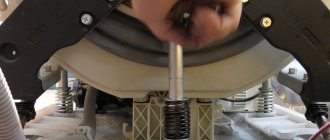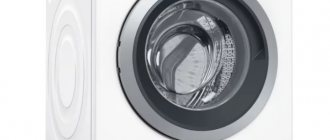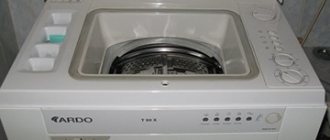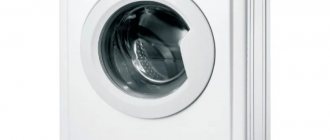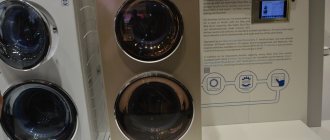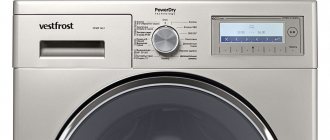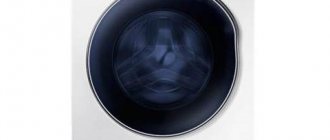Cleaning function: operating features
The process of cleaning laundry is in many ways similar to regular washing. There are several stages in the process:
- Using the pre-wash mode.
- Switch to main mode. First, the wash is done at 60 degrees, at 150 rpm.
- The program ends when using a double rinse, together with a spin, accompanied by maximum speed.
Maintenance monthly cleaning should be enough to prevent serious gaps from forming. It is recommended to remove all debris from the drain tank before using the function.
The use of this mode does not eliminate various formations in the form of scale.
Features of the mode
The function will help keep the washing machine clean and avoid mold, and prevent the appearance of unpleasant odors. This is an excellent mode that cleans the inside of the device. Thanks to it, the car can be rid of various insoluble particles, such as sand, wool, fabric residues and other debris.
If you regularly turn on the drum cleaning mode, the housewife will never have to clean the machine from mold, since the device operates at a high temperature (about 60 degrees), and its speed reaches 150 revolutions per minute.
This process is step-by-step:
- The first step is to start the pre-wash function.
- After it, the main one is activated, just at this moment the water is heated to 60 degrees, and the rotation speed of the washing machine drum increases.
- The last stage is double rinsing and spinning.
The program runs for almost an hour and a half. It is recommended to turn it on at least once a month.
So how do you clean your drum? Instructions for enabling additional mode:
- Since this program is separate, it is activated with just one button. However, before starting, you need to check the drum for foreign objects, forgotten clothing and debris. Afterwards, close the machine door, turn on the washing machine and press the star button for three seconds. The last action is to click “Start”.
- The program does not require powder or descaling agent; it works “idle”. The manufacturer does not recommend adding any means, as they may cause the device to malfunction.
LG drum cleaning function: proper activation
In most models, the function is programmed so that only one button needs to be pressed. What actions need to be taken?
- It is necessary to remove all things and any foreign objects from the drum.
- Next, close the hatch.
- First, the start button is pressed. Next, hold and press the buttons on which the stars are displayed, and at least three seconds should pass. You need to wait until the text tei appears on the panel.
- The function starts when you press the Start button, as in other cases.
- The program usually completes in 1 hour 35 minutes. Afterwards, the drum needs to be dried completely, leaving the hatch open. This completes the cleaning of the drum in the LG washing machine.
It is not recommended to add detergents or cleaning agents during cleaning. Otherwise, a large amount of foam will form and the equipment may freeze.
Drum cleaning function in LG washing machine
Modern LG washing machines are equipped with a special “drum cleaning” function. This program is designed to rid the tank, drum and rubber pipes of the unit from fungal formations and insoluble substances, and also serves to increase the service life of the equipment.
Features of the mode
Alas, not all housewives know that the LG washing machine, which has a special function, is not recommended to be cleaned with any means, especially citric acid, vinegar, or soda:
- vinegar solution increases the aggressive environment, and this is undesirable for parts;
- soda corrodes aluminum alloys in the machine, and the aggressiveness of alkali can increase when interacting with other chemicals;
- citric acid has a negative effect on rubber elements, primarily on the door seal.
To clean the drum, you should not add any powder or special descaling agents. The program will do its job itself, all you have to do is turn it on.
In fact, the machine needs to be “scrolled” in idle mode, this is all done before the first wash after installing a new “machine” at home.
Scope of application of the cleaning function
The drum, where stale laundry is placed and where detergents get in, is more susceptible to contamination than other parts of the washing machine. It also comes into contact with hard, poorly filtered water containing harmful impurities:
- Iron
- Technical, edible oils
- Rust
- Chlorine
- Calcium and magnesium salts
With frequent use of the machine, especially in large families, the drum constantly remains wet, with puddles and smudges.
An environment favorable for the development of microorganisms and bacteria that pose a threat to health is formed. The situation is aggravated by the habit of some housewives of storing dirty clothes directly in the washing machine.
Regular cleaning of the Lg washing machine drum is necessary to get rid of grease, mold and dirty deposits, dissolve fabric particles and lint.
Worth remembering! The function will not rid the heating element (heating element) and drum of scale.
To prevent pieces of delicate fabric from clogging the inside of the machine, they should be washed in special bags.
How does it work?
Many housewives do not know how the drum cleaning function works in the Lg washing machine, trying to get rid of plaque and mold with folk remedies - vinegar, soda and citric acid.
Attention! Conventional products are not safe for parts:
- Vinegar creates an aggressive environment in the drum of the machine, and it must be used very carefully, without exceeding the dosage.
- Citric acid damages the seal around the door and other rubber elements.
- Soda is an alkali; it corrodes aluminum and its alloys. In combination with other chemicals, the aggressive effect is enhanced.
A special built-in function knows how to clean the drum of an LG washing machine without harming the mechanism:
- Pre-wash mode is activated
- Main wash at a temperature of 60 C and a motor speed of 150 rpm
- Spin and rinse twice.
The standard operating time of the program is 1 hour 35 minutes.
Attention! The manufacturer does not recommend adding descaling agents or powder when performing the cleaning function - it causes a large amount of foam, which can lead to leakage.
Instructions for using the function
Important! Cleaning the drum in a machine equipped with a specialized function occurs without detergents or cleaning agents. The drum must also be empty.
To run this program you must follow the instructions:
- turn on the washing machine by pressing “Start”;
- find 2 buttons marked with a snowflake (*), press and hold for 3 seconds;
- a subsequent click on “Start” starts the cleaning function;
- The operating time of this function is one and a half hours;
- At the end of the cleaning process, it is necessary to leave the hatch ajar in order to dry the drum.
How to enable the feature?
How to use the function correctly:
- Remove foreign objects
- Close the door
- Simultaneously press 2 buttons “intensive” and “no folds”, marked with an * (asterisk), holding them for 3 seconds until the letters “tei” appear on the indicator.
- Press the “Start” button
- After the program has completed, open the door and wait until the drum is completely dry.
Advice! Before turning on the function, you should inspect the drain hose for blockages and clean the filter.
Models with drum cleaning function
These characteristics will help you make a choice among models that have a drum cleaning function.
F1048ND and F1280ND5 - belong to the middle price category. Linen capacity – 6 kg. Equipped with 9 modes, including quick and daily wash, allowing you to refresh laundry that does not have stubborn stains in a short period of time. The second model, in addition to the standard programs, has “Child Protection”, “Protection against Leaks”, “Down Products” and “Spinner”.
Cleaning: why is the function needed?
Along with the laundry that is loaded into the machine, the following items may get inside washing machines:
- Coins.
- Pins with paper clips.
- Threads.
- Lint particles.
- Fabric fibers.
- Sand particles.
It is necessary to carefully check the things loaded inside to avoid serious damage in the future. Lumps of dirt must be removed. If you are washing a delicate item, you cannot do without using a special bag.
Using dirty water often leads to problems and blockages. The parts inside the machine collect scale due to the salt contained in the metals. An excellent solution for many problems is special compositions and filter substances for liquids. Calgon and Alfagon are one of the acceptable options.
What substances can be used for cleaning?
You can use popular recommendations to get rid of dirt if there is no cleaning function. Special chemicals also help, but they must be selected with extreme caution.
Here are just a few acceptable “helpers” in solving the problem:
- Vinegar.
- Soda.
- Lemon acid.
Each option has negative and positive sides.
Application of citric acid
This is the most common product used to remove scale, mold, and traces of grease. It is enough to take 200 grams of dry acid powder to perform one cleaning procedure. When using such tools, the advantages will be as follows:
- Possibility to use automatic drum cleaning mode.
- Safety for constituent components.
- Availability.
- Low cost.
The disadvantage is that citric acid will not be effective if the contamination case is particularly severe. It will be difficult to clean the inside of the device if the drum has not been cleaned for many years. It will be necessary to apply citric acid several times, or choose another method that is more effective.
Using baking soda
Baking soda is suitable for getting rid of dirt accumulated on the walls. But the tank and heating elements will require other methods.
The procedure involves using only 150 grams of the substance.
The method has the following advantages:
- Safety of machine parts.
- Efficient in drum cleaning.
- Availability.
- Low cost.
The disadvantages are that the cleaning process is done manually. In addition, you need to wait a certain time for the soda to interact with water.
Using baking soda requires following the following sequence:
- The walls of the machine are slightly moistened. But you can’t moisten it with plenty of water.
- Pour a little product onto a rag.
- We wait half an hour until the active substances begin to interact with each other.
- Dirt is completely removed with a cloth.
What about vinegar?
This is a concentrated substance that can be used to clean various parts of washing machines. 50 milliliters of the product are diluted with the addition of 150 ml of water. Vinegar essence cannot be used without such dilution.
The cleansing process does not require additional actions from the user. The product has a low price. The procedure is also effective. But vinegar is quite difficult to wash out of the inside of the drum. Rubber parts of cars may be damaged by the substance.
Application of traditional cleaning methods
In the fight for cleanliness, all means are good. But in the case of using food additives, such as acetic and citric acid, you need to take into account the possible risk of their harm to the device. Their regular use with an incorrectly selected dosage can cause:
- clogging of the drain filter and further breakdown of the pump;
- deformation of the hatch cuff;
- damage to the metal part of the drum;
- wear of internal plastic parts.
The likelihood that cleaning with such substances will do more harm to equipment than good is high. But opponents of household chemicals, who are accustomed to fighting pollution with the help of food substances, will solve this problem using traditional methods.
How to make a drum cleaner at home, read below.
Method one: descaling with acetic or citric acid
Any acid that reacts with salts effectively removes mineral deposits. Lemon is used in the following way:
- Take 100 grams of the substance for every 6 kg of washing machine load.
- Pour the measured amount into the powder cuvette.
- Choose a long wash cycle with a temperature of at least 60 °C.
- After the end of the cycle, an additional rinse is performed.
Using acetic acid involves the same actions as with lemon juice: pour 50–100 ml of vinegar into the powder receptacle and set the longest washing program.
For greater efficiency, you can pause the machine in the middle of the cycle for 1 hour, and then continue washing.
Method two: cleaning mold with baking soda
To prepare soda powder, you need to take 250 grams of soda and dilute it in 250 ml of warm water.
On a note! Today you can find ready-made soda solutions for household use. Look for liquid soda on the shelves with household chemicals.
Then proceed as follows:
- The prepared mixture is applied to the internal contaminated areas of the drum and vigorously wiped with a sponge.
- Leave the machine in this state for 30–60 minutes.
- Start the wash with the maximum water heating temperature.
- Set the double rinse mode.
If it was not possible to remove all dirt and mold the first time, the procedure should be repeated.
Any cleaning of the washing machine is carried out on a “idle” (without laundry inside) wash.
Such simple folk cleaners really solve the problem of plaque and mold. But you can use them no more often than once every 2 months, and it is better to abandon them altogether in favor of proven special preparations.
Use of household chemicals
You can use various means to solve the cleaning problem. Usually this is “Belizna” and other chlorine bleaches, or professional preparations. Chlorine-based products do an excellent job of removing contaminants of any origin. But it is worth remembering that chlorine also negatively affects any parts made of rubber. The substances also have a negative impact on human health.
Special means
Frisch Aktiv is a specialized cleaning product developed by specialists from Germany. Thanks to modern technologies, an option has emerged that can be used for cleaning without much harm, even if the procedure is carried out weekly. This solution is effective, and various parts located inside the device do not suffer from such effects.
How to use chemicals?
For a safe and effective cleansing process, it is important to know in advance how to properly use a particular product. “Whiteness”, citric acid or vinegar suggest that the following instructions will help:
- First, the product is poured into the drum.
- We set the standard washing program lasting 1 hour. Temperature regime – not lower than 60 degrees.
- After the wash is completed, the double rinse starts.
- When the device is completed, the machine is left open to dry everything.
As for the Frisch Activ development, its application will be slightly different:
- Half of the cap is placed inside the cuvette.
- The other half is poured directly into the drum.
- At high temperatures, a cold wash starts.
- The scale should soak in the water, along with the product.
- Then the rinse mode starts.
The drum can be called an indicator, which always shows how dirty other parts are. If scale accumulates on the walls of the drum, it means that it is present in large quantities on other surfaces. Therefore, cleaning can be carried out for other parts, including tanks and pulleys, heating elements, rubber hatch cuffs, and drain filters.
Regarding pollution prevention
Dampness and high humidity create a favorable environment that promotes the development of mold and fungi. The cause of bacterial growth is debris, dirt and detergent residues that settle on the following parts:
- Rubber based door seal.
- Drain hose.
- Filter.
- The design of the tray where the powder is placed.
Cars also deteriorate from frequent washing of items that have been damaged by contamination from greasy substances.
Limescale is another source of contamination. An insoluble precipitate is formed due to the presence of salts and various impurities in the water. The process of precipitation formation begins when the liquid is heated to a certain temperature. The heating elements become covered with scale, which only increases in size over time. Electricity consumption increases, the heating process does not proceed correctly.
It is recommended to comply with the following requirements and rules for prevention:
- After washing, always leave the hatches open for at least one and a half to two hours.
- Carry out preventive cleaning with vinegar and citric acid. It is enough to use them 1-2 times every 2-3 months.
- Completely flush cleaning agents out of the tray.
- Use the high temperature program at least every week. The main thing is not to set the indicator above 75 degrees, otherwise scale will continue to form.
Experts confirm that the cleaning function makes the machines more reliable. Their condition remains normal for a long time.
Pollution prevention
Dampness and warm temperature in the washing machine after washing are a favorable environment for the appearance of fungus and mold . Debris, dirt and unwashed detergents, settling on the rubber door seal, drain hose, filter and powder tray, cause germs to multiply. Also, washing items heavily soiled with greasy substances leads to the settling of undissolved sediments on the drum, tank and rubber cuffs.
The source of drum contamination is often limescale. Due to the presence of salts and impurities in running water, an insoluble precipitate forms when heated. As a result, the heating elements are covered with a layer of scale, which increases over time, preventing thermal conductivity. This affects the quality of water heating and energy consumption.
To prevent dirt and scale, you must:
- Wash at high temperature at least once a week, but up to 75 degrees, since scale formation begins at this value;
- wash out any remaining detergent from the tray;
- wipe the hatch seal dry;
- 1-2 times every 2-3 months (depending on the operation of the machine), carry out preventive cleaning with citric acid or vinegar;
- ventilate the tank after washing, leaving the hatch ajar for an hour to an hour and a half.
Taking into account the feedback from washing machine repair specialists, models with a drum cleaning function are kept in a neater condition and are less prone to breakdowns. This is explained by the fact that users are more willing and often to clean the machine of accumulated dirt with this program, since it does not require cleaning agents or physical effort.
Important! It must be remembered that careful maintenance of the sanitary condition of the machine extends its service life.
Which machines support the cleaning function?
LG boasts a wide range of washing machines. But the function we are interested in is not present in every model. The main thing is that the cost does not change much in the presence or absence of such an opportunity.
Description of budget options
- LG F1048ND.
Supports 22 additional functions, together with 9 main programs. A narrow variety of machines, the drum is cleaned automatically.
- LG F1280ND5.
Silver model. Supports 22 additional modes, main programs – 14.
- LG F1280NDS.
The model has small dimensions in width and supports steam and hypoallergenic washing.
Mid-level price category
- LG F-1296ND3.
Supports up to 1200 rpm, additional laundry loading function. Easily supports baby wash and delicate fabrics, removes stains. Prevents additional stains from appearing on clothes.
- FH 2A8HDS4.
Applies to narrow models. Capacity is up to 7 kilograms. There is an inverter motor, which also helps support a large number of modes and functions.
- F-14U2TDH1N.
The machine can easily accommodate up to 8 kilograms of laundry. The device can dry up to 5 kilograms of clothes, in addition to the normal cleaning function. Smart diagnostics is one of the additional useful options.
- F-10B8ND.
Capable of washing up to 1000 per minute when there is up to 6 kilograms of laundry inside. There is additional protection against leaks, together with mobile diagnostics.
Where to look for a filter in an LG washing machine
Service centers say that many users, when seeking repairs, do not even know where the drain or drain filter is located. Since it is unknown where the element is, no one thought to clean it.
In LG brand SM it is located in the lower right corner on the front panel. It is hidden by a small technical hatch.
The lid can be opened without any tools or devices, simply by lifting it with your fingers. There's nothing special under the cover, just 2 parts:
- Round "plug".
- Thin hose for emergency drainage of water.
If the blockage is due to the machine stopping during washing, use the hose:
- Place a container to collect water.
- Remove the small but tightly fitting plug from the hose.
- Wait until the water drains (and this is a slow process).
To remove the so-called garbage filter, you need to unscrew the plug. The task is easy, no tools or effort required. But we will tell you in detail how to remove the filter on an LG washing machine so that everything goes flawlessly.
Tips for carrying out complex cleanings
Mold, unpleasant odors and dirt are problems that every equipment owner faces. You should regularly maintain the cleanliness of the elements located inside the device.
Washing the drum
Combining disinfectants with idle circulation is one possible solution to this problem. Regular citric acid can also be used. It is recommended to clean the rubber band only by hand.
The simplest processing option requires the following requirements:
- Carefully push the folds apart.
- Wash the cuff around the circumference. We use a sponge, soap, warm water.
- Wipe the surface of the part dry.
A solution of copper sulfate is used if the owner notices the appearance of mold spots. Another acceptable remedy is to prepare a cleaning paste that includes water and baking soda in equal proportions.
The purpose of the composition is to process not only rubber bands, but also the entire drum. The machines are kept in this position for two hours, then we wipe them with a sponge and start the long-term wash mode.
Working with filters and drainage hoses
An unpleasant odor is often caused by dirt particles that remain virtually invisible to the human eye. This is especially true for debris that could not be removed from clothing in time before being placed inside. It is recommended to clean drain filters at least once every three months. If the exploitation is active, then the work is carried out more often.
The operation involves removing the protective panel and a small container into which water flows. You can protect the floor with a cloth. The filter is unscrewed using counterclockwise movements. Then there is washing, with water under high pressure, the accumulated debris is removed from the hole.
When cleaning, the hose is simply disconnected from the parts to which it previously fits. The design and features of the part depend on which specific model of equipment is used by a particular buyer. If there are vertical models, the hose can only be reached using the side cover.
